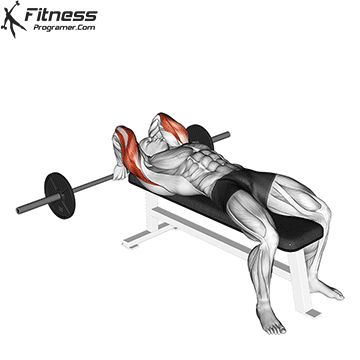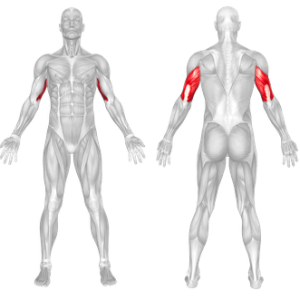Overview
The barbell lying back of the head triceps extension is a highly effective variation of the traditional skullcrusher. Instead of stopping the bar above the forehead, this version involves lowering the barbell further—past the head—until it reaches a position behind the head. This longer range of motion provides an intense stretch on the triceps, especially the long head, promoting hypertrophy and strength.
How to Perform

Setup:
Lie flat on a flat bench, feet flat on the floor.
Grasp an EZ-bar or straight bar with a shoulder-width pronated grip (palms down).
Start with your arms fully extended, holding the bar directly above your shoulders.
Execution:
Keeping your elbows pointed upward and tucked close to your head, slowly bend your elbows to lower the bar in an arc behind your head.
Your upper arms should stay stationary and perpendicular to the floor.
Lower the bar as far back as is comfortable, ideally until it’s level with or slightly below the bench height.
Engage the triceps to press the bar back up to the starting position without moving your shoulders or flaring the elbows.
Repeat for the desired reps.
Tips for Proper Form
Keep your elbows stable and close to your head throughout the movement.
Focus on moving only at the elbow joint to avoid using momentum.
Lower the bar in a slow and controlled motion to maximize the stretch.
Avoid letting the bar drift too far back, which can strain the shoulders.
Use a spotter if lifting heavy or if you are new to the movement.
Common Mistakes
Flaring the elbows outward, reducing triceps isolation
Using excessive weight and shortening the range of motion
Allowing the bar to drop straight down to the face instead of behind the head
Arching the lower back or shifting on the bench
Bouncing the barbell out of the stretched position instead of controlling the motion
Benefits
Long Head Emphasis: By stretching the triceps more deeply behind the head, this move maximally activates the long head.
Improved Triceps Size: The longer range of motion boosts hypertrophic potential.
Increased Time Under Tension: Greater muscular fatigue supports better strength and endurance gains.
Carryover to Pressing Strength: Helps strengthen lockout and elbow extension for overhead and bench pressing movements.
Versatility: Can be performed with an EZ-bar, straight bar, or dumbbells.
Muscles Worked

